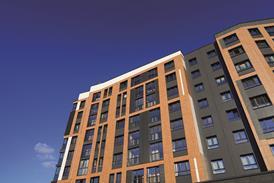The risk is that the modern incarnation of the terrace runs a greater risk of water penetration problems at the party wall than its predecessor. While tried-and-tested techniques prevent most problems on the regimented rows of cottages of the UK’s industrial towns, homebuyers of the late 20th century do not want houses laid out on gun-barrel straight rows. They want terraces to curl along crescents or step up a slope.
This is the root of the modern detail design problem. In a traditional terrace the party wall is just that, a wall that divides two homes, providing each with an internal wall. The wall is only exposed to the elements in the parapet that rises above the roof and stopping water hitting this section penetrating the home is easy to achieve using a capping block, flashings and a damp-proof course.
As soon as the layout of the adjoining houses becomes staggered, this simplicity is lost and designers face complicated waterproofing problems. The crux of these is that the party wall that ran through the roof to become a parapet, now serves as an internal wall where the houses overlap and an external wall where they don’t.
If the layout of a combination of roof flashings, damp proof courses and cavity flashings is not carefully thought out and skilfully built, moisture can more easily run through an external wall that then becomes an internal wall, causing damp and damaging finishes.
Paul Wornell, head of HAPM’s technical audit unit, is aware of the problem. “We don’t see it too often as a defect but we frequently see deficiencies in the detail on sites and on drawings. It is one of those things that is quite complicated but so often people don’t want to work it out.”
One catch is that the problem is often not addressed during design. “You can get quite complex detailing arrangements but there is a tendency for designers to fudge it and leave it to the tradesmen on site,” says Wornell. This view is backed by NHBC guidance that recommends that architects carefully detail the flashing detail on staggered party walls.
Architects who blindly follow British Standard Institute’s guidance can be caught out. The Standards covering this detail: BS8215 Design and installation of damp proof courses in masonry construction 1991 and BS5628 Code of practice for use of masonry Part 3: Materials, components, design and workmanship 1985, both show a flashing detail for the parapet on stepped terraces that will not prevent moisture permeating through the brickwork below the flashing. BSI is updating both standards but release dates are not yet set.
For designers who lack time to work out possible moisture paths and design a combination of damp proof course, cavity trays and flashings to combat them there are still solutions. Somerset-based Cavity Trays has addressed the problem with an integral cavity tray and flashing. Managing director and chief executive, John Shillabeer, says, “We’ve tried to design a system that is fully abuse-proof.”
Source
Building Homes



















